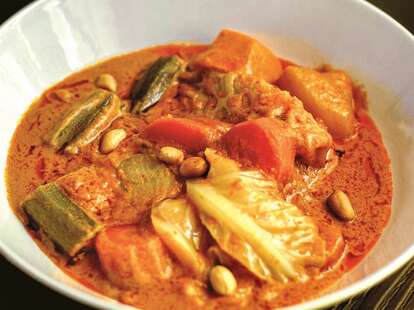Warm Up with This Recipe for Mafe, a Nutty African Stew
Marie Kocouchia’s latest cookbook ‘Vegan Africa’ transports you to the Ivory Coast and beyond.

The elements of cooking are as important as the finished product; the sound of sizzling garlic when making a stir fry, or the wafting aromas from freshly baked cookies can transport us to fond memories. In her latest cookbook, Vegan Africa, Marie Kacouchia harkens back to her vibrant childhood in Côte d’Ivoire and takes the reader along with her—whether that is to the fruit-and-vegetable-filled markets in Grand-Bassam or the smells of plantains frying in her mother’s kitchen.
“This cookbook is the materialization of my personal journey. As a young adult, I started questioning my identity, and naturally my relationship with food was at the center of this reflection. Why do I eat what I eat? How can I live a full life without inflicting suffering to other beings? And also, How come I know so little about my ancestral culinary heritage?” the Franco-Ivorian recipe developer explains. “I wanted to share the fruit of my research, to cast light on African cuisines, and inspire other people to learn more about them.”
Kacouchia dives straight into common misconceptions about African food, with the most widespread belief being that African cuisine is a monolith. There are, in fact, a plethora of them, each with its own defining characteristics and tenets. Cameroonians deploy Penja white pepper to season sauces. In Ethiopia, folks spice up a bowl of fava beans with mitmita, a popular seasoning mix. Another misconception is that African food is unhealthy, a stereotype Kacouchia combats through her wide array of nutritious, balanced, and vegan recipes.

“I am proud to dispel this painful myth that so many people—including some African people— carry: ‘nothing good comes from Africa’. And I try to do so one bite at a time,” she says.
Kacouchia’s vegetable mafe is the perfect antidote to these stereotypes. Full of a myriad of nourishing ingredients like ginger, African eggplants, and sweet potato. The stew is infused with a roasted peanut flavor, which, in Kacouchia’s own words, is “addictive.”
The recipe’s warmth, as well as the hearty portion sizes, encourage you to share it with the people who mean the most to you. Cooking the stew is a way for Kacouchia to communicate something words simply cannot: “[Food] is a language in its own. It is how I bond with other people, how I share a piece of my story, how I say I love you or I forgive you. When I cook or create a recipe, I am my true authentic self. I dare more and let down my guard,” Kacouchia says.
“And if I ever cook mafe for you, it means that I love you.”
Vegetable Mafe Recipe
Ingredients:
• 2 tablespoons argan oil (or other vegetable oil)
• 2 onions, minced
• 4 garlic cloves, minced
• 1 teaspoon grated ginger
• 1 cup (260 g) canned crushed tomatoes
• 2 vegetable stock cubes, crumbled
• ¾ cup (195 g) peanut butter
• 3 African eggplants or 1 small Italian eggplant, peeled and chopped
• 1 sweet potato, peeled and chopped
• ½ green cabbage, chopped
• 3 carrots, peeled and diced
• 2 turnips, peeled and chopped
• 1 habanero chile pepper or small sweet pepper
• 12 okra, trimmed and chopped
• Chopped peanuts (optional)
• Salt
• Black pepper
Directions:
1. Heat the oil in a large pot over medium heat. Add the onion, garlic, and ginger, and cook until the onion is translucent, 5 minutes. Stir in the tomato paste and stock cubes, then add 6 cups (1.5 L) water and simmer over low heat for 10 minutes.
2. Add the peanut butter and sit until it is fully incorporated. Add the eggplants, sweet potato, cabbage, carrots, turnips, and habanero. Stir carefully to avoid crushing the habanero.
3. Reduce the heat to low, cover, and cook until thickened, 1 hour.
4. Add the okra, season with salt and pepper, and stir. Cook until the vegetables are soft, 30 minutes.
5. Remove the chile pepper, sprinkle with peanuts if desired, and serve.
